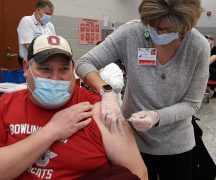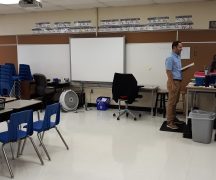By JAN LARSON McLAUGHLIN
BG Independent News
Across the nation, parents are checking their Netflix history to see if their adolescents have been watching the “13 Reasons Why” series.
The show tells the story of a high school junior who commits suicide. Prior to her death, she records a series of audio tapes describing the 13 reasons why she chooses to end her life. The story has parents and school officials watching for the slightest sign of copycat behavior from young viewers.
So they want kids to know this: When you die, you do not get to make a movie or talk to people anymore about how they wronged you. Leaving messages from beyond the grave is a dramatization produced in Hollywood and is not possible in real life.
Bowling Green City School officials held a program Wednesday evening for parents who have concerns about “13 Reasons Why” and its effect on their children.
“The reality is, students are watching this and we want parents to be equipped for it,” said Ann McCarty, executive director of teaching and learning.
In addition to a very graphic suicide scene of the main character cutting her wrists in the bathtub, the show also shows instances of rape, bullying, sexual assault, violence, drug and alcohol use.
“It’s a very graphic series,” said Jake Tapley, Bowling Green Middle School counselor.
Glaringly absent in the series are school staff or parents who intervene appropriately, Tapley said.
While some parents may have no idea that their children are watching the show, it is the talk of teenagers in the cafeteria, on the bus and on their phones.
Many students have told Tapley that adults are over-reacting to the show, and that teens aren’t going to commit suicide just because they’ve watched the drama. But those are the kids who are talking about it, he said.
The concern is that teenagers’ minds are already pretty messed up. “Puberty hits and hormones are kicking in,” Tapley said.
Mental health professionals are worried the series could be misinterpreted by impressionable and developing minds. The show could be seen as glorifying suicide as a viable response to problems and as a form of revenge.
The show also provides no helpful adults and no hope for depression. Worsening the impact is the fact that the Netflix series can be binge-watched in 13 hour-long episodes.
“The series could influence someone already at risk of suicide to choose to take their own life,” Tapley said.
School officials take the risk seriously, since suicide is second only to accidents as the leading cause of death for ages 10 to 24. Mental illness affects 20 percent of those 13 to 18 years old, and 11 percent of adolescents are living with a mood disorder such as depression, according to Elizabeth Syrowski, district behavior specialist.
Counselors are stressing with students that seeking help for mental health issues is always the right thing to do. And they are suggesting that parents talk with their children about the show and mental health struggles faced by their kids.
Warning signs were listed for parents.
Listen to your kids. “If you are hearing your child say they are a burden. If they talk about feeling trapped, like there’s no way out. They are hopeless,” Syrowski said.
Watch their moods. “Are they not taking care of themselves, like showering or eating?” Are they eating too little or too much, pulling away from friends, showing loss of interest, rage, irritability or anxiety?
Have their behaviors changed, such as:
- Increased use of drugs and alcohol.
- Looking for ways to kill themselves online, or searching for a gun, razor or drugs.
- Acting recklessly like driving erratically.
- Withdrawing from activities.
- Isolating themselves from friends and family.
- Sleeping too much or too little.
- Visiting or calling people to say “goodbye.”
- Giving away prized possessions.
- Showing aggression.
Children are waiting for adults to intervene. They may say, “Get out of my face, Mom, and leave me alone,” but they want to know parents care, Tapley said.
The creators of “13 Reasons Why” have said they made the suicide scene so graphic so it would not glamorize the act. But to some teenagers, the scene may be more like a “how to” video, Syrowski said.
“For someone with mental illness and depression, and already thinking of suicide, I don’t think it’s a deterrent,” she said. “They lack the ability to be able to see beyond the moment.”
The school officials offered suggestions to parents who have concerns about their children – the most important being talking and listening. Encourage kids to ask for help and to get involved with activities. Ask about changes in their school work, appearance, friend groups and other behaviors. Keep track of their digital footprint, contact school counselors, and install parent settings on Netflix.
Parents were also given lists of services available in school and in the community.
But only about 15 parents were at Wednesday’s presentation. Some attending said many parents are in denial that their children are watching the show.
One parent said she found out her 12-year-old daughter watched the entire series before she was aware of it. All the kids were talking about it around the lunch table, her daughter said. “As hard as it was, I knew I had to watch it,” the mother said. She was very troubled by the message and the graphic nature.
Another parent said her son has tried to commit suicide before. She asked him if he was watching “13 Reasons Why.” He denied viewing the show. “But I’m going to go home and check. I’m very worried now.”
Tapley suggested that parents talk to their children about the show. School staff have noticed girls painting their fingernails blue, like the main character does before she commits suicide. And a person in the audience said another school district has seen students assigning numbers to fellow students – coinciding with the 13 reasons why the teenager in the show killed herself.
“Maybe we have a smaller audience because people don’t want to hear about it,” Tapley said, “They don’t want to know.”





